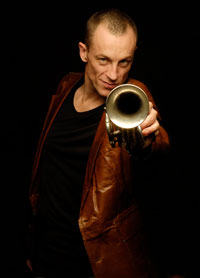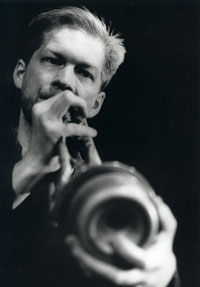Trumpets with an Edge by Marc Chénard
/ June 1, 2012
Version française...
Flash version here.
 1. Médéric Collignon: The Provocateur 1. Médéric Collignon: The Provocateur
Among the wild and wooly musicians making a name for themselves on the French jazz scene, trumpeter Médéric Collignon (now playing pocket cornet) is one of its flashiest musical personalities. Now in his early forties, this explosive musician has been making his mark in his home country with his tenures with the Orchestre national de Jazz de France (on two occasions), Andy Emler’s MegaOctet and on Louis Sclavis’ release Napoli’s Walls. Since 2006 this colourful personality, whose notoriety rests in no small part on his provocative statements, assumes his own destiny as the helmsman of his own quartet, Jus de Bocse, a band that will be on an eight-city cross-Canada tour with a stop in Montreal. The combo has released two Miles Davis tribute records thus far: first, Porgy and Bess, followed in 2010 by Shangri-Tunkashi-La (see jazz record review section).
Collignon took some time from a soundtrack mixing session in Paris to explain the group’s name: “It’s based on a play on words,” he says, “associated, on the one hand, with speaker boxes that came with old record players and, on the other, with the old French term ‘boxon,’ that means ‘mess’ or ‘untidiness.’”
After having previously explored the more ‘classical’ period from the Prince of Darkness’s śuvre, Collignon has struck again with a wild version of Davis’ electric period during the late 1960s, early 1970s, including some surprising arrangements scored for a section of four French horns. “It’s an old Mahlerian fantasy,” he notes. Additionally, this album, which alludes to the mythical land of Shangri-La and the Indian legend of Tunkashila, is charged with symbolic meaning, something he considers important in his own music: as stated elsewhere, he “does not make music for sounds, but for symbols.” When asked about this, he responds that he is interested in more than the relationships between sounds, but also in those occurring between musicians and the given context, even if it means questioning everything, such as when to play this note or that phrase at a given time.
This quest is apparent both from a personal standpoint and in instrumental approach. He admits to being influenced by Don Cherry, not only on a musical level, but on a spiritual one as well. Equally important to him is his vocation as a singer, unconventional as it is: as a child, he sung in choirs. Nowadays he uses it in a much more instrumental manner.
As for his main influence, Miles Davis, he considers him to be something of a “good cook,” one who knew how to mix the right ingredients, those being the musicians around him and of whom he constantly demanded to never rest on their laurels.
In concert in Edmonton on June 23; Vancouver, June 24; Victoria, June 26; Saskatoon, June 27; Ottawa, June 28; Montreal, July 5; Quebec, July 6; Halifax, July 7.
The complete interview (in French only) is available online at http://jazzblog.scena.org
 2. Axel Dörner: The Quiet Innovator 2. Axel Dörner: The Quiet Innovator
Like the Frenchman above, German Axel Dörner has also pursued his muse on the trumpet, but no two musicians are as dissimilar as these. Whereas Collignon is never at a loss for words and openly outspoken, Dörner is most unassuming, self-effacing to the point of self-erasure, always weighing his words carefully. Not one to be keen on taking up leadership duties, he is far more at ease as a sideman or working in co-op-type situations where responsibilities are equally shared.
A Berlin resident since 1994, this Cologne native is actually one of the most sought-after musicians in today’s European improv music scene. He is active in a good 10 groups at this time, trios and quartets mostly, occasionally duos, and even the odd solo concert where he extricates all imaginable sounds out of his particular instrument, the Firebird. Originally built for the late Maynard Ferguson, this collector’s item trumpet is equipped with a longer tuning slide, thus enabling the playing of quarter tones.
While based in Europe, Dörner has also traveled extensively, both in Asia and twice to Canada in recent years. In 2009, he was part of the Monk’s Casino project (a quintet playing the pianist’s work) and, the following year, a member of the legendary free jazz ensemble, the Globe Unity Orchestra, still led to this day by pianist Alexander von Schlippenbach. This month, the trumpeter is once again on tour, now as part of a sextet led by Dutch violist Ig Henneman (a group that includes two Canadians: clarinettist Lori Freedman and pianist Marilyn Lerner).
Dörner for his part is very much involved in a music scene that deals with sonic exploration rather than a more conventional approach based on melodic and harmonic development. Yet he is very much at home with the language of jazz, as demonstrated in the Monk project, but also in a new group, Peeping Tom, a quartet with similar instrumentation to that of Ornette Coleman’s original unit but which revisits compositions of bop pianists like Tadd Dameron, Dodo Marmarosa, even Herbie Nichols. On the flip side of the coin, he has worked with tenor saxophonist John Butcher and clarinettist Xavier Charles in a wind trio whose prime goal is to draw out every sound imaginable outside of the legit ones. What’s more, he willingly experiments with live electronics, as in a recent duo with electro-acoustic artist Jassem Hindi. While he does not disdain working in more traditional settings he also perceives their limits: “After time, it occurred to me that the well-tempered system was too constraining because one would eventually play melodies that sounded like something else. Since there are just 12 semitones in an octave, you’ll wind up playing a familiar melody at some point.”
In concert: Montreal, June 21; Ottawa, June 22; Toronto, June 24; Banff, June 26 and Vancouver June 28
Translation: John Delva
Version française... |
|


